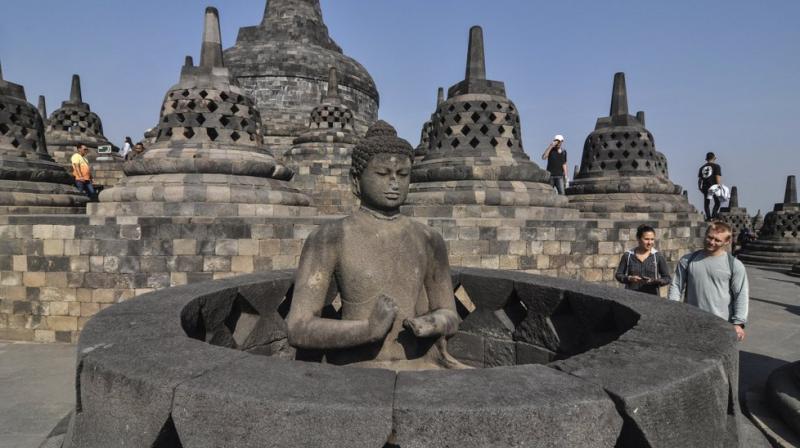Indonesia hopes to develop more tourism sites
Not just Bali: Indonesia hopes to develop more tourism sites.

Yogyakarta: Hundreds of tourists, many of them young Westerners, sat on gray stone steps atop the world’s largest Buddhist temple, occasionally checking cell phones or whispering to each other as they waited for daylight.
Sunrise wasn’t spectacular on that recent summer day. But even an ordinary dawn at Borobudur Temple — nine stone tiers stacked like a wedding cake and adorned with hundreds of Buddha statues and relief panels — provided a memorable experience.
The 9th century temple is in the center of Indonesia’s Java Island, a densely populated region with stunning vistas. Other highlights include the towering Hindu temple complex of Prambanan, like Borobudur a UNESCO World Heritage site, and Mount Merapi, the country’s most active volcano, whose lava-covered slopes are accessible by jeep.
While the two temples draw many visitors, other foreigners head to the relaxing beaches of Bali, just east of Java and by far the most popular tourist destination in a nation of thousands of islands and almost 270 million people. More than 6 million tourists visited Bali last year, or about 40 percent of 15.8 million visitors to Indonesia overall, according to official figures.
Recently reelected President Joko Widodo wants to change this dynamic by pushing ahead with “10 new Balis,” an ambitious plan to boost tourism and diversify Southeast Asia’s largest economy.
Key to the plan is to upgrade provincial airports and improve access to outlying destinations, such as Lake Toba on Sumatra Island, more than 1,300 kilometers (800 miles) from Jakarta, the capital. Yogyakarta, the provincial city from where visitors head to Borobudur and Prambanan, is getting a second airport, expected to be fully operational later this year.
Widodo has been promoting his plan in meetings with foreign leaders and in recent interviews, including with The Associated Press, in hopes of encouraging foreign investment. The president of the world’s most populous Muslim-majority nation told the AP in late July that as part of his push, he would like to see more business ties with the Middle East.
“For investment and tourism, we would like to invite investors from the Middle East as much as possible because ... we have many tourism locations in Indonesia, not only one or two or four, but many,” said Widodo. He did not give specifics.
Muslim tourists, including from the Middle East, might also be an easier fit for some of the more conservative areas earmarked for tourism development. Tourism officials have played down the possibility of cultural friction that might accompany the influx of more non-Muslim visitors, arguing that Indonesia’s brand of tolerant Islam can accommodate everyone.
“Maybe there are some particular locations that are very strict (religiously),” said Hiramsyah Thaib, who heads the “10 New Balis” initiative. “We believe we won’t have any problems. Sometimes we have problems in the media, but not in reality.”
Yet Islamic hard-liners have become more assertive in recent years, potentially spooking investors by undermining Indonesia’s image as a moderate nation. Thaib said he believes investor confidence rose “significantly” after Widodo defeated former special forces general Prabowo Subianto in April’s presidential election. Subianto had been backed by Muslim groups favouring Shariah law.
The tourism plan remains key to Widodo’s final five-year term, though at least one target — 20 million visitors this year — appears to have been too ambitious. The 2019 visitor tally is expected to be 18 million, based on current growth figures, said Thaib.
Still, the Indonesian tourism sector grew by 7.8 percent in 2018, or twice the global average, according to the World Travel and Tourism Council. One of the 10 sites earmarked for development is the Borobudur Temple area and nearby Yogyakarta, a city of several hundred thousand people that is embedded in a large metro area. The city is a centre of Javanese culture and a seat of royal dynasties going back centuries.

